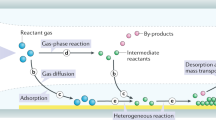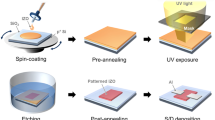Abstract
Metal oxides are emerging as important materials for their versatile properties such as high-temperature superconductivity, ferroelectricity, ferromagnetism, piezoelectricity and semiconductivity. Metal-oxide films are conventionally grown by physical and chemical vapour deposition1,2. However, the high cost of necessary equipment and restriction of coatings on a relatively small area have limited their potential applications. Chemical-solution depositions such as sol–gel are more cost-effective3, but many metal oxides cannot be deposited and the control of stoichiometry is not always possible owing to differences in chemical reactivity among the metals. Here we report a novel process to grow metal-oxide films in large areas at low cost using polymer-assisted deposition (PAD), where the polymer controls the viscosity and binds metal ions, resulting in a homogeneous distribution of metal precursors in the solution and the formation of uniform metal–organic films. The latter feature makes it possible to grow simple and complex crack-free epitaxial metal-oxides.
This is a preview of subscription content, access via your institution
Access options
Subscribe to this journal
Receive 12 print issues and online access
$259.00 per year
only $21.58 per issue
Buy this article
- Purchase on Springer Link
- Instant access to full article PDF
Prices may be subject to local taxes which are calculated during checkout




Similar content being viewed by others
References
Elshabini-Riad, A. & Barlow III, F.D. Thin Film Technology Handbook (McGraw-Hill, New York, 1998).
Smith, D.L. Thin Film Deposition (McGraw-Hill, New York, 1995).
Lange, F.F. Chemical solution routes to single-crystal thin films. Science 273, 903–909 (1996).
Brinker, C.J. & Scherer, G.W. Sol-Gel Science: The Physics and Chemistry of Sol-Gel Processing (Academic, New York, 1990).
Kozuka, H., Kajimura, M., Hirano, T. & Katayama, K. Crack-free, thick ceramic coating films via non-repetitive dip-coating using polyvinylpyrrolidone as stress-relaxing agent. J. Sol-Gel Sci. Technol. 19, 205–209 (2000).
Takenaka, S. & Kozuka, H. Sol-gel preparation of single-layer, 0.75 μm thick lead zirconate titanate films from lead nitrate-titanium and zirconium alkoxide solutions containing polyvinylpyrrolidon. Appl. Phys. Lett. 79, 3485–3487 (2001).
Yu, S., Yao, K., Shannigrahi, S. & Hock, F.T.E. Effects of poly(ethylene glycol) additive molecular weight on the microstructure and properties of sol-gel-derived lead zirconate titanate thin films. J. Mater. Res. 18, 737–741 (2003).
Hengerer, R., Bolliger, B., Erbudak, M. & Gratzel, M. Structure and stability of the anatase TiO2 (101) and (001) surfaces. Surf. Sci. 460, 162–169 (2000).
Bach, U. et al. Solid-state dye-sensitized mesoporous TiO2 solar cells with high photon-to-electron conversion efficiency. Nature 395, 583–585 (1998).
Tang, H., Prasad, K., Sanjines, R., Schmid, P.E. & Levy, F.J. Electrical and optical-properties of TiO2 anatase thin-films. Appl. Phys. 75, 2042–2047 (1994).
Huang, J.Y. et al. High-resolution transmission electron microscopy study of defects and interfaces in epitaxial TiO2 films on sapphire and LaAlO3 . Phil. Mag. A 82, 735–749 (2002).
Murakami, M. et al. Anatase TiO2 thin films grown on lattice-matched LaAlO3 substrate by laser molecular-beam epitaxy. Appl. Phys. Lett. 78, 2664–2666 (2001).
Park, B.H., Li, L.S., Gibbons, B.J., Huang, J.Y. & Jia, Q.X. Photovoltaic response and dielectric properties of epitaxial anatase-TiO2 films grown on conductive La0.5Sr0.5CoO3 electrodes. Appl. Phys. Lett. 79, 2797–2799 (2001).
Findikoglu, A.T., Jia, Q.X., Reagor, D.W. & Wu, X.D. Electrical characteristics of coplanar wave-guide devices incorporating nonlinear dielectric thin-films of SrTiO3 and Sr0.5Ba0.5TiO3 . Microwave Opt. Technol. Lett. 9, 306–310 (1995).
Author information
Authors and Affiliations
Corresponding author
Ethics declarations
Competing interests
The authors declare no competing financial interests.
Rights and permissions
About this article
Cite this article
Jia, Q., McCleskey, T., Burrell, A. et al. Polymer-assisted deposition of metal-oxide films. Nature Mater 3, 529–532 (2004). https://doi.org/10.1038/nmat1163
Received:
Accepted:
Published:
Issue Date:
DOI: https://doi.org/10.1038/nmat1163
This article is cited by
-
A Generalized Polymer Precursor Ink Design for 3D Printing of Functional Metal Oxides
Nano-Micro Letters (2023)
-
Measuring the viscosity of films by thermomechanical analysis: application to metal organic precursor films of functional oxides
Journal of Thermal Analysis and Calorimetry (2023)
-
Role of seed layer in van der Waals growth of vanadium dioxide film on mica prepared by chemical solution deposition
Journal of Sol-Gel Science and Technology (2021)
-
In-plane orientation-dependent metal-insulator transition in vanadium dioxide induced by sublattice strain engineering
npj Quantum Materials (2019)
-
Spontaneous cationic ordering in chemical-solution-grown La2CoMnO6 double perovskite thin films
NPG Asia Materials (2019)



